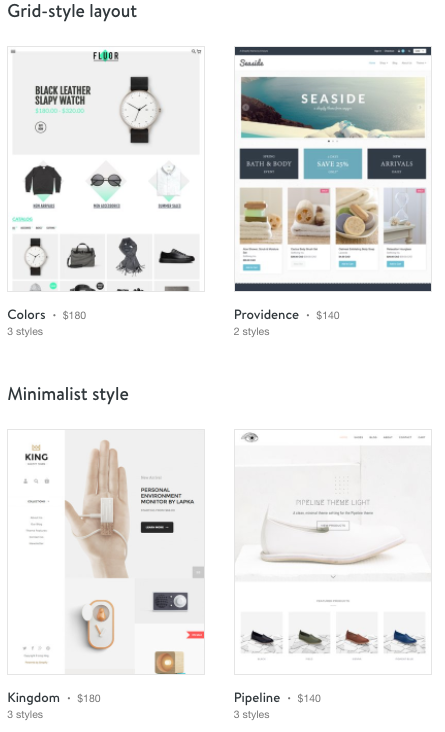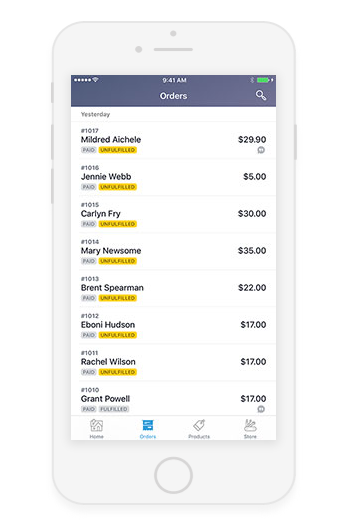
Choosing the right website builder for eCommerce is not as straightforward as it may seem. In a market with literally dozens of good options, it can be difficult to know what the best one for your online store might be. Shopify is one of those good options and there are many compelling reasons as to why you should consider the platform for both your web store and your bricks-and-mortar shop.
The Shopify brand is familiar to even the most novice users. Known for its ease of use, great design, and quality of its software, Shopify has built a great image for itself. But does it live up to the hype? Read on for our take.
Review Outline
Read review sections by clicking the links below:
- Pros and Cons
- Getting Started
- Template Selection
- Shopify Mobile
- Shopify Security
- Shopify Premium
- Conclusion
Pros and Cons
- Pros
- Cons
- Shopify provides some of the best customer service on the market. Their 24/7 phone and live chat support assistants are really knowledgeable and on-the-ball. You can also opt to send an email to the service and in our experience, the turnaround time was quick and provided the answers we needed. If you are based in North America, the United Kingdom, or New Zealand you can even use a regional phone number. This is all in addition to an already comprehensive user guide, FAQ, and highly active user forum. It’s impossible to get lost using Shopify.
- The templates on Shopify are attractive and modern. Their professional design puts Shopify among the best website builders available. Each template is broken down into one of eight categories: Home, Clothing, Food, Accessories, Art, Electronics, Books, and Other. Users are not limited by theme, but each category features optimized themes. The Spotify theme store features over 100 free and paid templates, but we were fairly satisfied with the selection of free choices.
- Shopify has a huge app store with more than 600 different apps (and counting) for you to choose from. These tools range from backend tools like accounting and inventory management to front end features like social media sharing. The Shopify App Store is one of the best features on the platform. One thing to keep in mind, however, is that many of them are paid apps and as enticing as certain features may be to you, the costs will add up. Quickly.
- An understandable, yet frustrating element in Shopify is that many advanced features are available only to those on a higher payment tier. These include the ability to accept and use gift cards, professional reporting, abandoned cart recovery (ie, messages users who leave your site with something in their card), the advanced report builder, and third-party calculated shipping rates. These power features are important to even basic users, so incentivizing them is a poor call by the service.
- Nobody wants to feel like their eCommerce provider is skimming off of their bottom line. Yet, under the Basic plan, Shopify charges 2.9% and 30 cents on every online transaction. These rates are reduced to 2.5% and 2.25% under the Professional and Unlimited plans, respectively. Each tier also charges a reduced rate for in-person credit card processing. These fees add up.
- Shopify lies on the costlier side of eCommerce website builders. Their services are well featured, but you are definitely paying for what you get, especially with the upper tier plans. Make sure you use the 14-day free trial because once you decide to pay, Shopify does not offer refunds.
Getting Started
Setting up a Shopify store is simple. An average user will be up and running within a matter of clicks, needing only to provide an email address and password. Once you sign in for the first time you will be taken through a step-by-step process where Shopify will do things like help you name your store, choose your domain, and calculate tax rates and currency type based on your address.
The Shopify dashboard is really easy to figure out. Everything is simple to figure out and Shopify even reminds you to complete certain actions if they remain unfinished. You can tell that the service listens to their users based on how good the user interface is.
Template Selection
 Shopify offers over 100 premium templates for you to choose from. Their professional designs will give you credibility and create trust with your visitors. While there is an adequate level of free temples, many of them will cost you.
Shopify offers over 100 premium templates for you to choose from. Their professional designs will give you credibility and create trust with your visitors. While there is an adequate level of free temples, many of them will cost you.
The paid themes range in price from anywhere between $60 and $200, which might be expensive for new businesses. Themes can easily be changed, however, and the layout of your store will convert automatically.
For new businesses, we recommend starting with a free theme. They are just as well designed as the premium themes and as your eStore grows, so too will your layout.
Shopify Mobile
Because Shopify has both online and in-store capabilities, they have two apps that users can download. Shopify and Shopify POS are available on iOS and Android and they offer users rich features no matter how they’re selling.
Shopify App
The Shopify app allows users to manage and fulfill orders on the go. You can stay up to date with business insights and tools, and even add new products by uploading photos, pricing, and writing descriptions.
The app is one of the best we’ve used and we were happy to see it making use of features like push notifications, where we were notified every time a new order was placed.
Shopify POS
Shopify may be known for their eCommerce platform, but their in-store point of sale (POS) system is a breeze to use. Users who sign up for the service will receive a free credit card reader that plugs into the headphone jack of iOS and Android devices. For users whose phones lack a headphone jack (read: iPhone 7 users), Shopify also offers a wireless card reader for $89. This turns your phone or tablet into a mobile POS system, potentially saving hundreds on a desktop-based system.

Using the Shopify POS app you can simply add products to a customer’s cart, apply discounts, accept all payment forms, and even email customers their receipts. It’s an elegant solution, but we don’t recommend it for supermarkets or other high-traffic stores.
Shopify POS is ideal for handling the needs of boutiques and low-traffic shops.
Shopify Security
Despite the prevalence of online shopping, customers continue to be concerned with hacking, data leaks, and insecure browsing. Shopify can help alleviate the difficult task of keeping your customers safe on your website.
Shopify takes care of all the security updates needed to make your eBusiness safe and secure for both you and your customers. These include server upgrades and backups. Shopify takes care of your customer data and uses the latest security features customers are prone to look for, like SSL certificate and 128 bit encryption.
Shopify Premium
Shopify’s tiered pricing system is pretty detailed and somewhat confusing, especially because the platform can be used both online and in-store. All plans offer in-store purchasing but keep in mind that you will have to add an additional $49 per month and purchase all of the necessary equipment like stands, receipt printers, card readers, and cash drawers.

Basic Shopify
The Basic plan costs $29 per month and offers a wide range of features but lacks some advanced options that upper tier Shopify users receive. Under the Basic plan, users are charged 2.9% + 30¢ for online transactions and 2.7% for in-person transactions. An additional 2% is added if you want to use an external payment gateway like PayPal or Amazon Payment.
Shopify
The Shopify plan costs $79 per month and includes most of the advanced options that upper tier Shopify users receive. Under the Shopify plan, users are charged 2.6% + 30¢ for online transactions and 2.5% for in-person transactions. An additional 1% is added if you want to use an external payment gateway.
Advanced Shopify
The Advanced plan costs $299 per month – a pretty big and significant leap, if you ask us – and includes all of the advanced options that upper tier Shopify users receive. Under the Advanced plan, users are charged 2.4% + 30¢ for online transactions and 2.4% for in-person transactions. An additional 0.5% is added if you want to use an external payment gateway.
Shopify Lite
A new Lite plan allows users to sell products on Facebook, in-person, or on an existing website. Its features include the ability to chat with customers and potential customers using the Messenger platform, add products to any website or blog, and accept credit card payments. The transaction fees are similar to those of the Basic plan.
Conclusion
Shopify is a serious option for anyone looking to build a beautiful, powerful, and convenient eCommerce website. They have been in the industry for long enough to become the most recognizable name and the usability of the site just keeps increasing. Our main qualms lie in the price of the product and the add-ons, but in this case, you really do get what you pay for.





